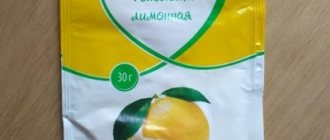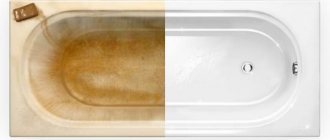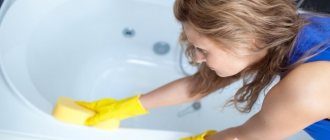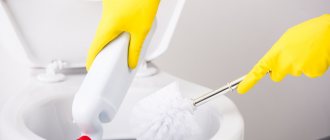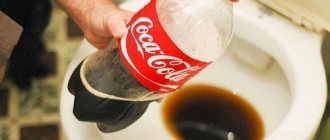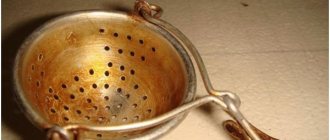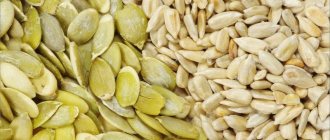An increased amount of mineral impurities in tap water contributes to the gradual formation of a yellow coating on the surface of the bath.
To remove it and return the plumbing to its former cleanliness, use home remedies and household chemicals. The choice of cleaner, as well as the operating technology, depends on the material of the bowl.
We'll tell you in this article how to clean a cast-iron, enameled, acrylic bathtub from yellow deposits at home.
How to remove yellowness using improvised means?
Traditional methods help to cope with yellowness no worse than store-bought bleaches.
Recipes based on weak acids and alkalis are considered the most effective and accessible.
Soda and peroxide
Sodium bicarbonate has good cleaning properties. To speed up and enhance cleaning, it is recommended to use hydrogen peroxide together with soda.
The algorithm for using this tool is simple:
- Baking soda and peroxide are mixed in a 2:1 ratio.
- Apply the paste to the yellow spots.
- Leave the product on the walls for about an hour.
- Rub all problem areas with a sponge.
If the yellow coating is old and thick, then repeat the cleaning with soda and peroxide.
Lemon acid
The crystalline powder, used in cooking, is also known as an effective anti-rust agent. remove yellow and orange stains using this organic acid as follows:
- Dissolve 25 g of powder in a glass of water.
- Apply the solution with a sponge to the stains.
- Leave for half an hour.
- Repeat acid treatment 4 more times.
Soda and laundry soap
This recipe helps to cope with a small light yellow coating. The removal procedure includes several steps:
- grate the laundry soap and pour in a little water;
- add baking soda to the dissolved soap mass;
- Rub the problem areas with soap and soda slurry with a sponge;
- leave the product for a while;
- Rub the stain again with a sponge.
A paste of soap and soda can be prepared in larger quantities for future cleaning and stored in a closed jar.
Peroxide and ammonia
Both products are not in short supply and are easy to purchase at the pharmacy.
Discoloration of yellow spots is carried out in this order:
- hydrogen peroxide and ammonia are mixed in a ratio of 1:2;
- pour the prepared solution onto the yellow stains;
- wait about a quarter of an hour;
- wipe the bath with a sponge or cloth;
- If necessary, the treatment is repeated.
Acetic acid
To work, you need 9% table vinegar. If the contamination is weak, you can limit yourself to a weaker solution.
Cleaning is carried out as follows:
- Soak a cloth selected according to the size of the stain in vinegar.
- Apply a “compress” to the contaminated area.
- Wait 1-2 hours until the yellowness is completely discolored.
- To prevent the napkin from drying out, it is periodically moistened with vinegar.
If the entire bath is covered with yellowness, then warm water is poured into it, 1-2 liters of vinegar are added and left for 10-12 hours.
Table salt and wine vinegar
Salt, along with soda, is used more often than other bulk products by housewives for cleaning premises and cleaning objects. This is a strong abrasive that can cope with even serious stains. Vinegar can enhance its effect. To prepare a product that can be used to clean the bathtub from yellowness, use any vinegar. But wine is preferable, as it has a pleasant aroma.
This composition can even cope with old stains, but re-treatment may be required. Recipe for preparing the mixture:
- pour 100 ml of vinegar into a glass container;
- add 2 tbsp. l. salt;
- mix;
- place in the microwave to heat the mixture to + 65°C;
- moisten a sponge with the mixture and treat the contaminated surface;
- rinse with water and repeat the procedure if necessary.
How to remove stains with special compounds?
The assortment of hardware stores offers many special gels, liquids, powders against rust or limescale.
Cleaners differ:
- composition,
- instructions,
- volume,
- at a price.
Unicum
The sanitary ware is intended for cleaning the bathroom. The spray is suitable for:
- ceramics,
- enamel,
- porcelain,
- become,
- plastic.
The formula of the product includes a mixture of organic acids, nonionic surfactants and fragrance.
Use the liquid according to the instructions:
- Spray the spray onto the bath from a distance of 20-25 cm.
- Maintain a full reaction time of 15-20 seconds.
- Wipe the area with a soft brush or cloth.
- Persistent stains are re-treated with exposure for up to 1 minute.
A 500 ml spray bottle costs an average of 500 rubles.
Mr. Chister
Acrylic bathtub cleaner helps remove:
- yellowness,
- rust,
- limescale,
- fungus.
Gives the surface shine, suitable for frequent washing:
- enameled,
- ceramic,
- acrylic,
- steel surfaces.
Includes:
- NSAS,
- lemon acid,
- antibacterial component,
- fragrance,
- preservative
Cleaning of plumbing equipment is carried out according to the following scheme:
- The spray is sprayed onto the contaminated area.
- Allow the product to react for 2-3 minutes.
- With strong yellowness, the exposure time is increased.
- Wipe the treated area with a sponge or rag.
The average price for a standard 500 ml bottle is 160 rubles.
Bagi Acrilan
A universal remedy for rust, lime and fungus. Foam spray whitens and disinfects the surface of plumbing fixtures from:
- enamel,
- acrylic,
- ceramics,
- chromium.
The active ingredients are nonionic surfactants, citric acid and solvents.
Instructions for use require compliance with the following rules:
- Shake the bottle of foam well.
- Moisten the surface to be treated with water.
- Spray Acrylan evenly onto the stains.
- Leave the product for 1-2 minutes.
- Wipe with a damp cloth or rinse with water.
A bottle with a spray (400 ml) costs about 420 rubles in online and offline stores.
Best Cleaning Gels 2022
Gel products are characterized by a thick consistency. They are easy to apply and evenly distributed. Cleaners made in Russia and Japan are popular among Russian housewives. One bottle of product is enough for a month of bathroom care.
Advantages and disadvantages
suitable for quick surface treatment
exhibit cleaning and disinfecting properties
not only clean, but also eliminate unpleasant odors
when used correctly, do not cause allergic reactions
Most are universal, suitable for different surfaces
there is no dispenser, you have to pour the gel out of the neck
may have a runny consistency, which increases consumption
the smell is quite strong
Synergetic: against most contaminants
Synergetic
Synergetic gel is an environmentally friendly product that completely decomposes in the environment. The product of the Russian manufacturer does not contain chlorine. Suitable for cleaning any surfaces, including chrome faucets and plastic products. Eliminates unpleasant odors, protects against bacteria, and does not reduce its effectiveness in cold water. The average price package is 170 rubles.
Sanfor Expert 2 in 1: for acrylic and chrome surfaces
Sanfor Expert 2 in 1
An inexpensive universal product specially designed for “finicky” coatings. They can be used to clean bathtubs, tiles, and chromed metal. It is enough to apply a thin layer of the gel and rinse with water after a few minutes. There is no pungent odor. The price does not exceed 20 rubles per bottle.
Homestar: Best Bathtub Cleaner
Homestar
The thick product is economical to use , spreads in an even layer, and cleans sanitary ware made of ceramics, acrylic, and enamel well. The Japanese manufacturer has created an effective formula without chlorine. The narrow spout makes it easy to squeeze out the gel in small portions. The product copes with yellow rust stains and plaque. Budget gel can be found on the shelves of chain stores for only 55 rubles.
Clean Home: professional gel formula
Clean Home
Clean Home Gel is available in 800 ml plastic bottles with a dispenser. The narrow spout and finger grooves at the top of the bottle make application easy. A thick gel with a biodegradable formula is applied to the walls and bottom of the bathroom. After 15 minutes, wash off with water without using mechanical cleaning. The cost of packaging is 120-150 rubles .
Sarma “Disinfection”: economical concentrated product
Sarma
The main action of the gel concentrate is aimed at destroying bacteria . The product contains oxalic acid. The neutral odor is due to the absence of chlorine. A small amount of gel is applied to the walls using a sponge and washed off after 10 minutes. This is how a cheap domestic product returns the whiteness to the bathtub. Stubborn stains should be scrubbed with a brush. Price - 100 rubles per 500 ml bottle.
Cleaning features depending on the type of coating
Modern bathtubs can be made of cast iron, steel, and acrylic. In most cases, metal bowls are coated with enamel, which requires careful handling during operation and cleaning.
Cast iron
It is advisable to wash bathtubs made of this alloy once a week. For normal hygiene procedures, use laundry soap or gel detergent . Cast iron bowls can be cleaned with weak acids (acetic, citric).
The porous alloy does not withstand the effects of gasoline, chlorine, and strong acids. You should also avoid using abrasive pastes and powders.
Acrylic
To maintain whiteness, it is recommended to clean plastic bathtubs with special products no more than once every 10-14 days. For such baths, it is advisable to purchase gels and foams designed specifically for acrylic products.
Do not rub the polymer plastic bowl . Preventive washing is carried out using washing gel or washing powder.
Steel
Bowls made of stainless steel, like cast iron, are covered with enamel. However, this layer is thinner and therefore more sensitive to the effects of cleaning agents.
For bleaching, it is recommended to use soft equipment (napkins, sponges, rags) and gentle products. It can be:
- weak acids;
- baking soda;
- ammonia;
- hydrogen peroxide.
Enameled
The glossy coating on the metal bowl requires regular washing, but special cleaning is carried out no more than once every 7 days. It is recommended to avoid strong acidic and chlorine-containing compounds, as their use can cause irreversible yellowing of the surface.
The enamel tolerates citric, oxalic, acetic acids and hydrogen peroxide well. It does not withstand harsh abrasives, but is lightened when using baking soda or soda ash.
Tips for keeping your bath white
It is quite difficult to completely avoid the formation of limescale and dark marks on the walls and bottom of the bathtub. The main reason for their occurrence is the evaporation of water with residues of shampoo, body gel, soap, etc. They contain substances that are not completely washed off, accumulating over time on the bathtub coating.
Much also depends on the quality of the water itself - the harder the water, the more limescale marks it leaves. After rusty water, a yellow-brown coating appears.
However, if you use our tips, you will be able to keep your bath clean and shiny longer and use special detergents less often.
- After each use of the bath, treat its walls with a damp, soapy cloth and rinse with warm water.
- Wipe the bathtub dry after washing or washing.
- To prevent rusty deposits, you need to ensure that the taps do not leak.
- Do not use metal sponges or sandpaper, or powders with hard granules for cleaning. Try to avoid scratches - the more microcracks there are in the enamel, the faster it will become dirty and more difficult to clean with detergents.
- It is necessary to put a rubber mat on the bottom to protect the surface from scratches if the bathtub is used for washing bowls or other metal products, as well as for bathing animals.
- If you are too lazy to wash and wipe the bathtub every time, we recommend applying window cleaning liquid or special products that keep the glass clean: Titan, Tilex, Amway onto its surface from a spray bottle. They break down particles of limescale and grease, preventing the appearance of dark marks. The downside of such products is the constant smell of chemicals in the room and unnecessary waste of money. This advice is only useful for families who use showers and do not take baths.
What can't be used?
When cleaning the bathtub, you should remember that not all products and tools are universal. Some of them can cause damage to enamel, acrylic or metal surfaces.
To avoid damaging your plumbing when removing yellow stains, it is recommended to exclude:
- Steel wool and brushes. Hard products leave scratches, as a result of which the bathtub will require cosmetic repairs.
- Strong acids and alkalis. These reagents can ruin acrylic and enamel and thin the walls of a metal bath.
- Products intended for cleaning toilets. Such gels contain aggressive components that can damage the bathtub coating.
Causes of yellow plaque
The main reason for yellowing of the bathtub is poor-quality tap water containing impurities of heavy metals, salts, and chlorine. The poor condition of metal sewer pipes increases the risk of contamination. Flowing through an old sewer, water washes away deposits of rust, iron and dirt. These contaminants end up on the plumbing fixtures, resulting in unsightly marks that spoil the surface.
The main reason for yellowing of enamel and acrylic is low-quality tap water containing rust particles, chlorine and heavy metals.
Other causes of yellow spots:
- improper surface care;
- use of unsuitable cleaning products;
- infrequent cleaning and tidying.
When starting to clean the bathtub, it is necessary to determine the cause and nature of the stains in order to effectively get rid of yellowing and take the necessary measures to prevent stains in the future.
Useful tips
To remove yellowness and further maintain the cleanliness of the font, it is important to remember the following useful recommendations:
After each use, rinse the bathtub with warm water, then wipe dry with a soft cloth.- When using any plumbing product, it is advisable to wear gloves to protect your skin from irritation.
- Before removing yellow stains using household chemicals, you need to turn on the forced exhaust in the bathroom.
- The final stage of any cleansing with a special product is rinsing the bath with water and wiping dry with a napkin.
- You should not place metal cans and bottles on the sides of the bathtub, as they may leave rust marks.
- It is necessary to keep the faucet in good condition, since constantly dripping or flowing water leaves a persistent smudge.
All the most important and useful information about cleaning the bathroom is collected in this section of the site.
Baking soda
Soda was the main cleaning agent even before the advent of special abrasive powders. Its effect is achieved through mechanical action, but it cannot be used on all surfaces. An acrylic bathtub can be easily scratched and damaged, but a cast iron or metal bathtub can be cleaned in this way to remove yellowness.
All you need to do is put a little baking soda on a sponge and rub the problem area. There is no point in leaving soda on the surface, because it is only an abrasive that does not react with the surface. If baking soda doesn't work right away, it won't help in the future. Then it makes sense to combine it with something else, such as hydrogen peroxide.
Methods for bleaching a cast iron or steel enameled bathtub
Contamination from soap products and hard water often remains on metal products; organic residues after bathing (dead epidermal cells) can collect on the edges. Cast iron products are strong and resistant, so they can be cleaned with almost any means.
Yellowness, in addition to the aesthetic factor, poses a health hazard. Places where dirt, dust and moisture accumulate are a favorable environment for the proliferation of different types of pathogens. Therefore, it is important to effectively clean plumbing fixtures from yellow deposits.
Home remedies to clean your bathtub white
Not every product will whiten an old bathtub. To do this, you can use compounds that can corrode dirt, but do not damage the surface of the product. You don’t have to buy expensive household chemicals, but clean your plumbing with improvised means:
- Cleaning with soda and vinegar is suitable for whitening all plumbing fixtures, tiles, toilets, and other smooth surfaces. To prepare this recipe, you need to pour a little warm water with the addition of detergent (for example, liquid powder or dish gel) into a container with a spray bottle and mix until smooth. Then carefully add baking soda and pour vinegar on top - you will get foam that will effectively remove all contaminants. Simply spray the solution onto the contaminated surface, wait 10 minutes, and rinse with a sponge and clean water.
- A product made from remnants or grated soap. Pour a small amount of soap into a glass of boiling water and stir. Then add 1 tsp. ammonia and 1 tsp. soda, stir. Clean all surfaces in the bathroom with the resulting composition.
- To get rid of rust, you can use a mixture of turpentine and table salt. The ingredients must be mixed until a homogeneous paste is obtained, and applied to the rusty areas of the metal container.
- You can clean the bathtub with Whiteness bleach. Apply the product to a sponge, wipe the surface, after 5-10 minutes. wash off with warm water. If the inside of the container is completely dirty and yellow, fill the container full of water overnight, adding 1-2 liters of “Whiteness”. The chlorine included in the composition will clean the surface white. After cleaning, you need to ventilate the room, because... breathing chlorine fumes is harmful to health.
Household chemicals
Plumbing fixtures can be bleached using commercial cleaning and disinfection products. Top 3 most common remedies that have proven their effectiveness in practice:
- Ciff. Available in several forms - powder, gel, solution or spray. Choose a cleaner for metal or plastic products (acrylic). The creamy structure does not scratch the surface, penetrates into all microcracks, removes bacteria and dirt.
- Sannox. An acid-based product from a domestic manufacturer. Copes with all stains, disinfects, and refreshes the surface. Cannot be used for polymer products.
- You can clean your bathtub white with sprays or gels. Comet is a manufacturer of household chemicals that is popular all over the world. Available in different forms and cleans any surface.
